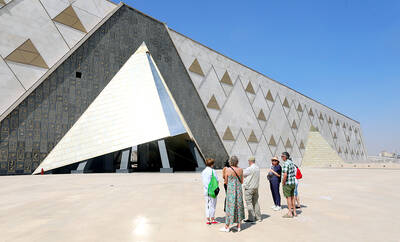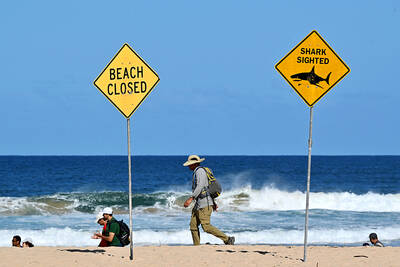Relief workers battled rain and choppy seas yesterday to deliver food and medicine to the country's northeast following devastating back-to-back storms that killed at least 568 people and left hundreds more missing.
The mayor of Real, one of the three coastal towns worst hit by flash floods and mudslides last week, said at least three mountain villages remain isolated from rescuers, though they were not believed to be as severely affected.
Philippine officials have appealed for international aid, but the bad weather and damaged infrastructure were hampering relief efforts.
President Gloria Macapagal Arroyo has blamed illegal logging for exacerbating the floods, and said those responsible would be prosecuted like hardened criminals. She also imposed a moratorium on logging.
Real and the nearby towns of Infanta and General Nakar, about 70km east of Manila, were accessible only by boats and helicopters. Ships were unable to reach far-flung villages because of floating debris, and rubber boats ferried relief goods from ship to shore.
"What we need are food, water and medicine, plus temporary shelter," Mayor Arsenio Ramallosa said. "Tents and even tarpaulins will do. Thankfully, we have had continuous flow of relief supplies and those that run out are being replenished."
He said workers clearing roads that were blocked by landslides were slowly making their way to Real, but he was told by engineers that large boulders may have to be blasted with explosive.
He said at least 250 people have been counted dead in Real, but that dozens more bodies were buried in a building that collapsed under a mudslide.
Most of the destruction was wrought by a tropical storm that blew through northeastern provinces Nov. 29, killing at least 530 people and leaving 607 missing. Typhoon Nanmadol struck the same region three days later, leaving 38 dead and 33 missing, according to the Office of Civil Defense.
In Infanta, next to Real, residents appealed to authorities to be allowed to leave on rescue helicopters delivering food aid. But casualties were given priority seats.
Mildred delos Santos tried unsuccessfully to get her 78-year-old mother, who is suffering from hypertension, and 10-year-old daughter on a helicopter to Manila. She said they saved themselves from debris-laden floodwaters by breaking a hole through their roof and getting on top of their house.
"It was terrible. We saw one family of about 15 cling to a tree, but the tree was also washed away by the flood. They died," she said. "They were pitiful. Those people were shouting for help but we could not do anything. We were on the roof."

With much pomp and circumstance, Cairo is today to inaugurate the long-awaited Grand Egyptian Museum (GEM), widely presented as the crowning jewel on authorities’ efforts to overhaul the country’s vital tourism industry. With a panoramic view of the Giza pyramids plateau, the museum houses thousands of artifacts spanning more than 5,000 years of Egyptian antiquity at a whopping cost of more than US$1 billion. More than two decades in the making, the ultra-modern museum anticipates 5 million visitors annually, with never-before-seen relics on display. In the run-up to the grand opening, Egyptian media and official statements have hailed the “historic moment,” describing the

SECRETIVE SECT: Tetsuya Yamagami was said to have held a grudge against the Unification Church for bankrupting his family after his mother donated about ¥100m The gunman accused of killing former Japanese prime minister Shinzo Abe yesterday pleaded guilty, three years after the assassination in broad daylight shocked the world. The slaying forced a reckoning in a nation with little experience of gun violence, and ignited scrutiny of alleged ties between prominent conservative lawmakers and a secretive sect, the Unification Church. “Everything is true,” Tetsuya Yamagami said at a court in the western city of Nara, admitting to murdering the nation’s longest-serving leader in July 2022. The 45-year-old was led into the room by four security officials. When the judge asked him to state his name, Yamagami, who

‘CHILD PORNOGRAPHY’: The doll on Shein’s Web site measure about 80cm in height, and it was holding a teddy bear in a photo published by a daily newspaper France’s anti-fraud unit on Saturday said it had reported Asian e-commerce giant Shein (希音) for selling what it described as “sex dolls with a childlike appearance.” The French Directorate General for Competition, Consumer Affairs and Fraud Control (DGCCRF) said in a statement that the “description and categorization” of the items on Shein’s Web site “make it difficult to doubt the child pornography nature of the content.” Shortly after the statement, Shein announced that the dolls in question had been withdrawn from its platform and that it had launched an internal inquiry. On its Web site, Le Parisien daily published a

DEADLY PREDATORS: In New South Wales, smart drumlines — anchored buoys with baited hooks — send an alert when a shark bites, allowing the sharks to be tagged High above Sydney’s beaches, drones seek one of the world’s deadliest predators, scanning for the flick of a tail, the swish of a fin or a shadow slipping through the swell. Australia’s oceans are teeming with sharks, with great whites topping the list of species that might fatally chomp a human. Undeterred, Australians flock to the sea in huge numbers — with a survey last year showing that nearly two-thirds of the population made a total of 650 million coastal visits in a single year. Many beach lovers accept the risks. When a shark killed surfer Mercury Psillakis off a northern Sydney beach last